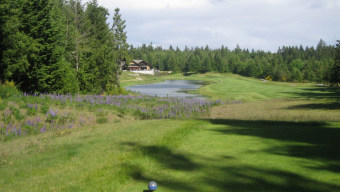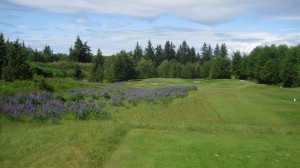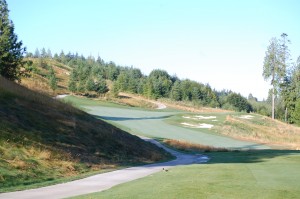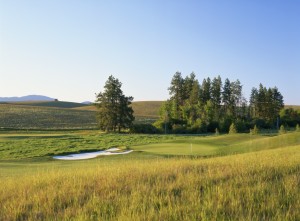KINGSTON, Wa. – Costs, access or the exposure to golf all seem to be conspiring to deter the young from taking up the game like their parents once did. Rounds are down as the game is trying to hang on amid the distractions of a thousand other things to do.
But there is hope for the game all around the country that comes from a most unusual source: Native Americans.
It’s a odd juxtaposition but golf in many parts of the country, particularly in the Northwest, is improving thanks to casino-connected Tribes. It’s actually a symbiotic relationship. Golf courses need the influx of cash (casinos) to build and maintain quality golf courses while the Native American communities have shown they can expand their clientele for their casinos and hotels with a golf course amenity.
“Their total commitment is very impressive,” said Bruce Christy, director for golf operations at White Horse Golf Club in Indianola, Wa. The course is owned by Port Madison Enterprises, the business arm of the Suquamish Tribe. The Tribe has poured millions into the purchase, development and improvement of the course, including opening its gleaming new clubhouse this spring.
“They’re very smart people, very business-oriented, very concerned about the community,” Christy said. “They do so much work in the community. They are extremely well received in the community for all the stuff they do. They donate millions a year to the community.
“It’s nice to see that level of commitment. It’s nice for someone to fund that project and not incur a tremendous amount of debt service that has lasting impact on course down the road.”
In fact, that’s how the Tribe ended up with the course, because the original developers of the near 400-acre property had so much debt service they declared bankruptcy. The Tribe eventually purchased the property in February 2010.
That just continued a trend throughout the country of casino-connected Tribes venturing into the golf business. In the Northwest, Native American communities operate such prominent clubs as Seven Cedars at Dungeness in Sequim, Wa. (Jamestown S’Klallam Tribe), Kah-Nee-Ta in Warm Springs, Ore., and Wildhorse in Pendleton, Ore. (Confederated Tribes of the Umatilla), Salish Cliffs (Squaxin Island Tribe), and Circling Raven in Worley, Idaho (Coeur D’Alene Tribe)
“It’s seems like (Native American) courses are doing the best in a golf industry that has gone flat,” Christy said. “They’re all doing well because they’re not stressed by debt service payments.
“All the tribes work universally to share information on what’s been successful. Nearly all the tribes work together. There are hundreds and hundreds all over the country. They’re all nice courses, usually tied to a casino, making money, as opposed to housing.”
Here’s a brief look at three of the most renown tribal courses in the Northwest – White Horse, Salish Cliff and Circling Raven.
WHITE HORSE
The Suquamish tribal leaders were convinced to purchase the White Horse golf property in 2010 not only because of the potential casino business at its nearby Clearwater Casino Resort but particularly because of concern for the land. This is the land of their ancestors. They needed to preserve and protect it from overbuilding and abuse.
“For the Suquamish, they want to be great stewards of the environment because a lot of the streams that run through the golf course also run to their fish hatchery,” White Horse’s Christy said. “That’s in front of the clamming and geoduck areas. White Horse is one of the (state’s) most regulated courses.
“The tribe’s fishery department works closely with (the course superintendent). We go through them. We’ve been in partnership with them the last three or four years. They’re a very competent bunch. They’re aware how committed we are as well.”
You can see how the course complements its setting the moment you drive into the parking lot, as the holes are cut through vast acres of firs. There are just a handful of homes on the course, on a couple back-nine holes. Otherwise, it’s virgin woods, peaceful, birdy and primitive.
When the tribe took over, there were three areas that needed improvement. One was making the transition from trailers to a new clubhouse. That was fulfilled in March when the club opened its new 20,000-square foot clubhouse, a magnificent wood-and-rock structure that fits nearly into the environment.
The other improvements were to the course itself, improving its maintenance, which fell off during its receivership, and ‘softening’ the course. The original architect, Cynthia Dye-McGarey, was applauded for her design, beauty and degree of difficulty. Yet it was too difficult.
Noted course designer John Harbottle was hired three years ago to make the course more playable for ordinary golfers. He took out 60 (of the 156) bunkers and more than 200 trees. He also graded greens edge for more accommodating ‘softer’ approaches, although you still notice the exceptional bounce throughout the entire layout.
“They (Tribe) very much takes a long view, a 50-year, 100-year project,” said Mark Luthman of Touchstone Golf Management, which manages the course. “It’s rare in our business to come across folks that have that type of long view.”
The changes have mattered. As Luthman points out, there were 22,881 rounds played in 2010, the year the Tribe took over. Last year, that number increased to 26,450 rounds.
“The Tribe is committed to improving the overall aspects of the golf course,” Christy added. “They come in with the mindset of what can they add to help us become successful.”
The course now stretches to 7,093 yards from the tips but there are other tee positions, black (6,693) and blue (6,176), plus a combo white/blue (5,913) and a white (5,524).
There are quite a few stunning holes but the signature hole is probably the one you see (pictured above) as you stand on the clubhouse patio, the par-4, 435-yard 18th. It’s a slight dogleg left with woods on the right and a lake all along the left side to the green. The undulating green sits amid bunkers while a slope along the left side that will take you ball to a watery grave.
SALISH CLIFFS
SHELTON, Wa. – Washington’s newest golf course – at a time when few courses open across the country – Salish Cliffs officially began play in September 2011. Architect Gene Bates, who, coincidentally, also designed Circling Raven, has his master hand all over this 7,269-yard layout. It’s a thoughtful and challenging course.
“He’s getting his name out there as just what a good architect he is,” said David Kass, who moved here from a comfortable job in Florida to take on a raw project that was little more than a vision when he arrived.
“I love it. It’s why I came here,” Kass said. “I jumped on the opportunity to come to new golf course. I don’t know how many would come to a place that still had dirt on the ground in some places and watch a course get finished, watch a clubhouse get built.”
He came because of the Squaxin Island Tribe’s commitment to excellence.
“They’re not cutting corners,” he added. “They don’t say, we’ll build a clubhouse five years down the road. Some courses have been around for 50 years and are still working on a plan.”
The Tribe, much like the other Native American golf properties, pay particular attention to the land and environment. This was the first golf course in the country, perhaps the world, that is certified ‘Salmon Safe.’ The course follows strict guidelines to protect water quality and salmon habitat. That might not mean much to the typical golfer but it sends a message that they value the land, which can only enhance your 18-hole nature walk (although take a cart).
Bates incorporated his design with the Tribe’s environmental concerns in mind. He carved the holes naturally through the tall forests. One of his distinctive features is his bunkering. His fairway bunkers look like someone dropped a giant egg, with low, erratic edges that blend seamlessly into the surrounding grasses.
“You’ll notice the fairway bunkers have a subtle tilt toward the green so you can always launch it toward the green,” Kass said.
One unique element on the wide-open course is the 15,000-square foot double green, shared by the 9th and 18th holes. It’s adjacent to the log-cabin-like clubhouse with an second-floor balcony overlooking all those three putts.
The par-5, 587-yard 10th hole may not be the course’s signature hole but it’s the one you’re remember on your drive home. It seems like 787 yards. There’s a long-grass rough on the left of your drive and a long-grass rough on your right of your second shot. With the prevailing wind in your face, after two decent shots the average golfer you could still face a 120-yard-plus approach to the green. It’s a big-boy hole.
The course is an amenity to the nearby Little Creek Casino and its 190-room hotel. Initially, about 15 percent of the guests also played golf. There are also various stay-and-play packages available.
CIRCLING RAVEN
WORLEY, Id. – This Gene Bates showpiece is celebrating its 10th anniversary and it may be one of the great unknown golfing treasures in the Northwest.
The course, about 25 miles inside the Idaho border from Spokane, is built around a casino and gleaning 300-room hotel, with new wings added a year ago to provide 98 more rooms.
Much like the other Native American courses, the environment is a top priority but just as important is providing employment for tribe members in this poor rural region. There are more than 2,000 employees, mostly Tribal members, working at the complex and the employer also provides them with health coverage.
In addition, millions in gaming profits are annually funneled into the local schools to help enhance educational benefits for many of the disadvantaged children. All the more reason to feel good when you step on the first tee.
Your trip to this rural outpost will be rewarded as the course is epic in proportions. It’s a 7,189-yard layout but it covers 600 acres (compared to 300 acres at Salish Cliffs). It meanders up and around the rolling hills, with the wind as your constant companion.
To say it’s challenging would be an understatement. It’s long. It’s windy. It’s bendy and it’s wide open, yet if you stray too far you won’t find your ball in the knee-high fescue.
There are four par-3, three of which are well over 200 yards from the back tees, 217, 212 and 253. The fourth one is a mere 192 yards.
Bates put a lot of effort into doglegs in which the safe play is point to point. He makes it hard to hook or slice a drive around a corner. The risk/reward element is very much in play. The safe drive is to hit to a close to the end of the fairway to position yourself well enough to turn right (or left) for your approach.
It’s hard to identify the signature hole but among the ones you’ll take home with you is the par-3, 212-yard third hole. Even from the forward tees, you still have to carry a sizable impenetrable rough with a series a bunkers protecting the green (if you can reach them) and thick rough on either side of the green.
When you come to Circling Raven, bring your big stroke.
























